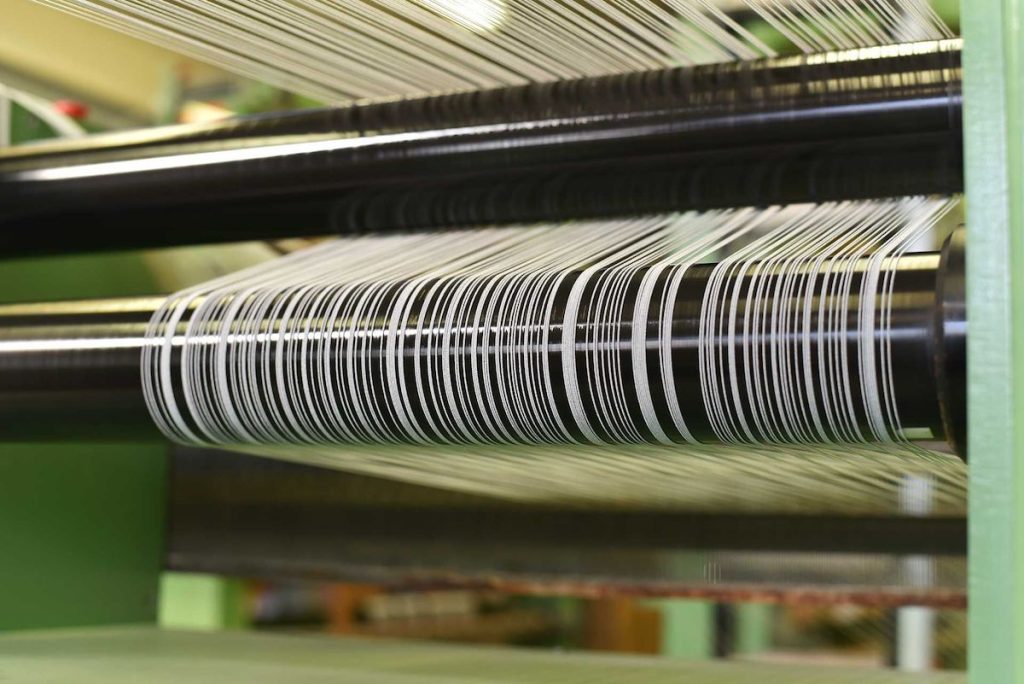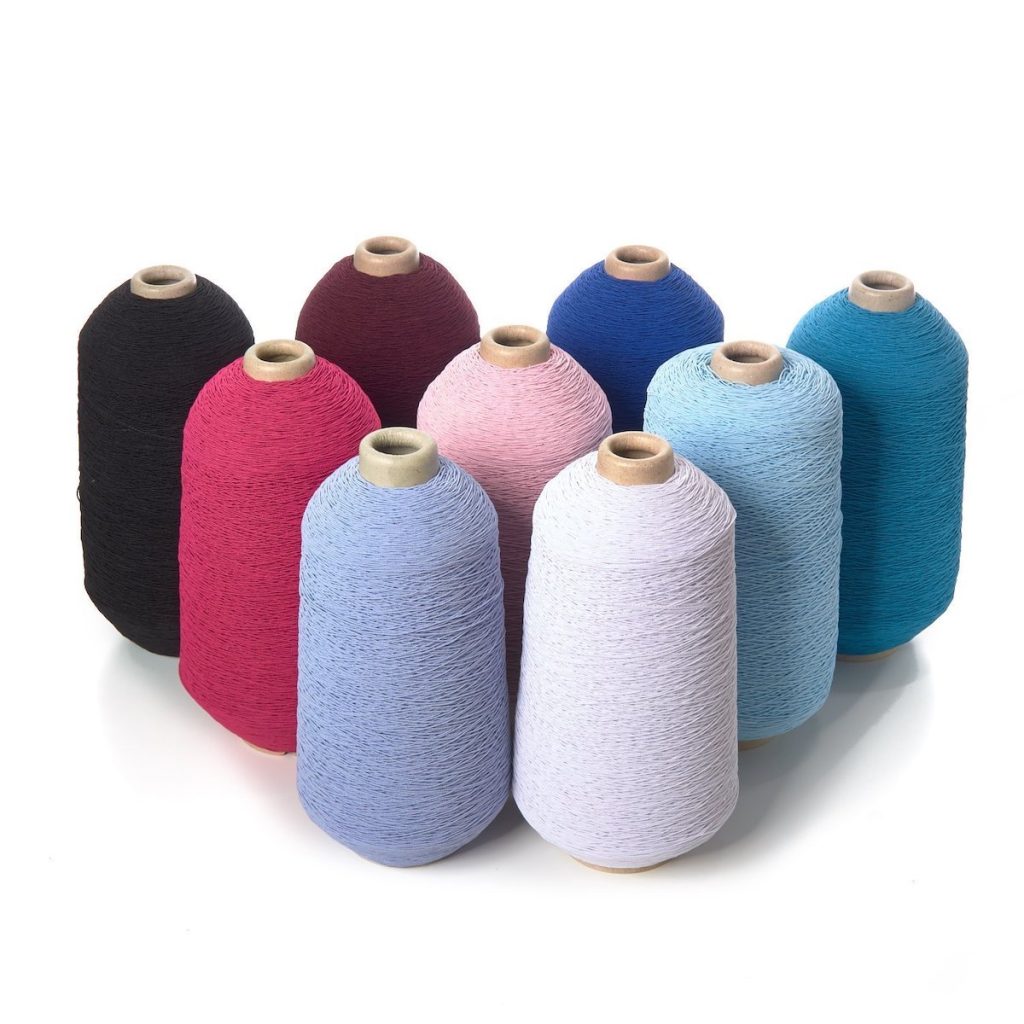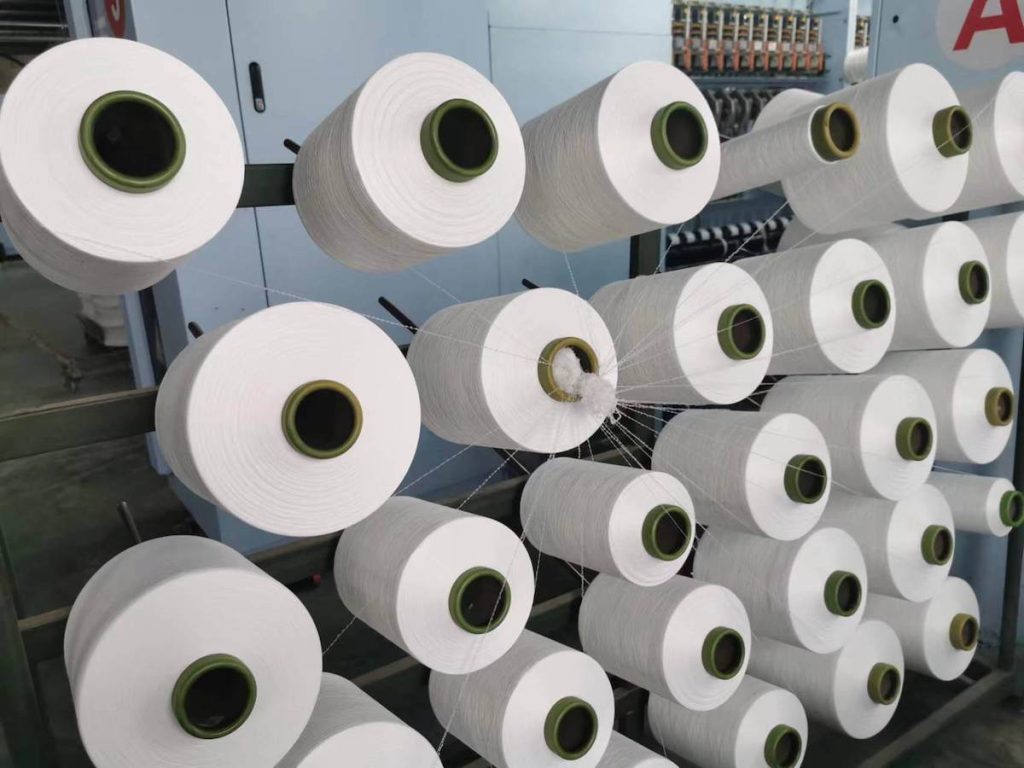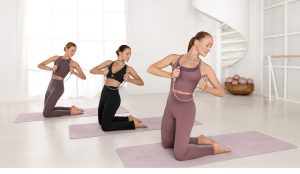Covered elastic yarn has emerged as a game-changing innovation in the textile industry, bridging the gap between functionality and style. This unique textile component combines an elastic core with an outer covering of various fibers, resulting in a versatile material that has transformed the way we approach clothing design and manufacture. As we delve into the intricacies of covered elastic yarn, we’ll explore its composition, production methods, applications, and the profound impact it has on the fashion industry and consumer preferences.

The Anatomy of Covered Elastic Yarn
Covered elastic yarn is a complex textile creation that marries elasticity with durability. At its heart lies an elastic core, typically made from materials such as spandex or rubber, which provides the stretch and recovery properties essential for many modern garments.

The Covered Elastic Yarn
The elastic core is the foundation of covered elastic yarn, responsible for its ability to stretch and return to its original shape. This core is most commonly made from spandex, a synthetic fiber known for its exceptional elasticity. Spandex can stretch up to 500% of its original length and quickly recover its shape, making it ideal for use in form-fitting and performance garments.
Rubber is another material sometimes used for the elastic core, particularly in specialized applications where specific properties are required. The choice between spandex and rubber often depends on factors such as the desired stretch characteristics, durability requirements, and the intended use of the final product.
The Outer Covered Elastic Yarn
Surrounding the elastic core is a protective and decorative outer layer composed of various fibers. This covering serves multiple purposes: it enhances the yarn’s durability, improves its appearance, and can add specific properties to the final fabric.
Common materials used for the outer covering include:
- Polyester: Known for its strength, wrinkle resistance, and quick-drying properties.
- Nylon: Valued for its durability, elasticity, and smooth texture.
- Cotton: Prized for its softness, breathability, and natural feel against the skin.
The choice of covering material significantly influences the characteristics of the final yarn and, by extension, the fabric it produces. For instance, a polyester-covered elastic yarn might be ideal for sportswear due to its moisture-wicking properties, while a cotton-covered variant could be preferred for comfortable, everyday wear.
The Synergy of Core and Covered Elastic Yarn
The combination of the elastic core and the outer covering creates a synergy that is greater than the sum of its parts. The elastic core provides the stretch and recovery, while the covering protects the core from damage, adds aesthetic value, and contributes additional properties to the yarn.
This synergy allows covered elastic yarn to maintain its elasticity while also possessing the characteristics of the covering fiber. For example, a nylon-covered spandex yarn can offer the stretch of spandex with the strength and smooth feel of nylon, making it perfect for swimwear and activewear.
Manufacturing Processes: Creating the Perfect Blend
The production of covered elastic yarn is a complex process that requires precision and expertise. There are several methods used to create this specialized yarn, each with its own advantages and applications.
Air Covering: Harnessing the Power of Air
Air covering is an innovative technique that uses compressed air to intertwine the elastic core with the covering fibers. This method is particularly effective for creating lightweight yet strong yarns with excellent stretch properties.
In the air covering process, the elastic core is fed into a chamber where it is surrounded by a vortex of covering fibers. The high-speed air current causes these fibers to wrap around the core in a spiral pattern, creating a uniform and secure covering. This technique allows for a looser covering compared to mechanical methods, resulting in a yarn that retains more of the core’s elasticity.
Air-covered yarns are often preferred for applications where maximum stretch and recovery are essential, such as in high-performance sportswear and compression garments. The lighter weight of these yarns also makes them ideal for use in sheer fabrics and delicate lingerie.
Single Covering: Precision Wrapping
Single covering is a mechanical process where the covering fiber is wound around the elastic core in a single direction. This method provides excellent control over the tension and density of the covering, allowing manufacturers to create yarns with specific characteristics.
During single covering, the elastic core is stretched and fed through a hollow spindle. The covering fiber is then wound around the core at high speed, creating a uniform and tightly wrapped yarn. The tension of the wrapping can be adjusted to achieve different levels of stretch and recovery in the final product.
Single-covered yarns are often used in applications where a balance between stretch and stability is required, such as in swimwear and form-fitting garments. The tighter wrapping provided by this method can also enhance the yarn’s durability and resistance to abrasion.
Double Covering: Enhanced Stability and Appearance
Double covering takes the single covering process a step further by adding a second layer of covering fibers. In this method, the elastic core is first wrapped with one layer of fiber in one direction, and then a second layer is applied in the opposite direction.
This dual-layer approach offers several advantages:
- Increased stability: The opposing directions of the two layers help to balance the forces within the yarn, reducing twisting and improving dimensional stability.
- Enhanced appearance: Double covering can create a smoother, more uniform surface, which is particularly desirable for visible applications in fashion garments.
- Greater protection: The additional layer provides extra protection for the elastic core, potentially increasing the longevity of the yarn.
Double-covered yarns are often chosen for high-end fashion applications where appearance and durability are paramount. They are also commonly used in garments that require a higher degree of opacity, such as leggings and shapewear.
Core-Spun Yarns: A Unique Approach
Core-spun yarns represent a different approach to combining elasticity with other fibers. In this process, the elastic core is fed into the center of a spinning system, where it is surrounded by staple fibers that are twisted around it.
This method creates a yarn that has the appearance and many of the characteristics of a traditional spun yarn, but with the added benefit of stretch. Core-spun yarns can be made to look and feel like 100% cotton or wool, for example, while still providing the comfort and fit advantages of elastic yarns.
Core-spun yarns are particularly popular in denim and other woven fabrics where a traditional appearance is desired along with stretch properties. They allow manufacturers to create “comfort stretch” garments that retain the look of classic fabrics while offering improved fit and ease of movement.
Applications Across Industries: From Fashion to Function
Covered elastic yarn has found its way into a wide array of products, revolutionizing various sectors of the textile and garment industries. Its versatility and unique properties have made it an essential component in everything from everyday clothing to specialized technical textiles.
Fashion and Apparel: Redefining Comfort and Style
In the world of fashion, covered elastic yarn has become a game-changer, allowing designers to create garments that combine style with unprecedented comfort and fit.
Activewear and Athleisure
The rise of athleisure has been closely tied to advancements in elastic yarn technology. Yoga pants, leggings, and sports bras all rely heavily on the properties of covered elastic yarn to provide the necessary stretch, support, and recovery. These garments need to move with the body during exercise while maintaining their shape over time, a challenge that covered elastic yarn meets admirably.
High-performance sportswear also benefits from the moisture-wicking properties of certain covering fibers, such as polyester, combined with the stretch of the elastic core. This combination creates fabrics that are not only comfortable and form-fitting but also functional in managing sweat and temperature regulation.
Denim and Casual Wear
The incorporation of covered elastic yarn into denim has led to the creation of “stretch jeans,” which have become a staple in many wardrobes. By using core-spun yarns or adding elastic yarns to the weft of the fabric, manufacturers can produce jeans that offer the classic denim look with added comfort and flexibility.
This technology has extended to other casual wear items as well, such as chinos and dress pants. The result is clothing that maintains a tailored appearance while providing the comfort and ease of movement that consumers increasingly demand.
Lingerie and Shapewear
Perhaps nowhere is the impact of covered elastic yarn more evident than in the lingerie and shapewear sectors. These garments rely on the precise balance of stretch, recovery, and comfort that covered elastic yarns provide.
Bras, underwear, and shapewear pieces use covered elastic yarns to create supportive yet comfortable garments that can smooth and shape the body. The ability to combine strong elastic properties with soft, skin-friendly covering fibers has revolutionized this sector, leading to products that are both functional and comfortable to wear for extended periods.
Medical and Compression Wear: Supporting Health and Recovery
Covered elastic yarn plays a crucial role in the development of medical textiles and compression garments, where precise control over pressure and stretch is essential.
Compression Stockings and Sleeves
Compression therapy relies on garments that apply graduated pressure to limbs, often to improve circulation or reduce swelling. Covered elastic yarns allow manufacturers to create stockings and sleeves that provide consistent, controlled compression while remaining comfortable and durable.
The ability to fine-tune the stretch and recovery properties of these yarns means that compression levels can be accurately targeted to meet specific medical requirements, from mild support for travel to stronger compression for managing certain health conditions.
Orthopedic Supports
Elastic yarns are integral to the construction of various orthopedic supports, such as knee braces, ankle supports, and back braces. These products need to provide firm support while allowing for a range of motion, a balance that covered elastic yarns are uniquely suited to achieve.
The durability of these yarns ensures that orthopedic supports maintain their effectiveness over time, even with repeated use and washing. Additionally, the use of antimicrobial covering fibers can help in creating supports that remain hygienic, an important consideration for medical applications.
Post-Surgical Garments
After certain surgeries, patients may be required to wear compression garments to aid in healing and reduce swelling. Covered elastic yarns enable the creation of garments that can provide consistent, comfortable pressure over extended periods.
These post-surgical garments often need to be worn for weeks or months, making the comfort and durability provided by high-quality covered elastic yarns essential for patient compliance and successful recovery.
Technical Textiles: Pushing the Boundaries of Performance
Beyond fashion and medical applications, covered elastic yarn is finding increasing use in technical textiles, where its unique properties are being leveraged to create innovative solutions for various industries.
Automotive Textiles
In the automotive industry, covered elastic yarns are used in the production of seat covers, headliners, and other interior components. These yarns allow for the creation of form-fitting covers that maintain their shape and appearance over time, even with frequent use.
The ability to combine elastic properties with durable, easy-to-clean covering fibers makes these yarns ideal for the demanding environment of vehicle interiors. They contribute to both the aesthetic appeal and the functional performance of automotive textiles.
Aerospace and Military Applications
Specialized covered elastic yarns are also finding applications in aerospace and military textiles. These might include pressure suits for pilots, where precise control over compression is critical, or in military uniforms that need to provide both freedom of movement and durability under extreme conditions.
The development of flame-resistant and high-strength covering fibers has expanded the potential applications of covered elastic yarns in these high-performance sectors, leading to textiles that can withstand extreme environments while providing the necessary comfort and flexibility.
Smart Textiles and Wearable Technology
As the field of smart textiles and wearable technology continues to evolve, covered elastic yarns are playing an increasingly important role. By incorporating conductive fibers or other functional materials into the covering, it’s possible to create stretchy, comfortable fabrics that can also transmit data or respond to environmental changes.
This opens up possibilities for garments that can monitor vital signs, adjust temperature, or even change color in response to external stimuli, all while maintaining the comfort and fit that consumers expect from modern clothing.
Market Dynamics and Global Production
The market for covered elastic yarn is a complex and dynamic landscape, influenced by factors ranging from raw material costs to shifting consumer preferences. Understanding these market dynamics is crucial for anyone involved in the textile and garment industries.

Global Production Centers
While covered elastic yarn is produced in many countries around the world, certain regions have emerged as key players in the global market.
Asian Powerhouses: China and India
China and India stand out as major producers of covered elastic yarn, benefiting from their well-established textile industries, large labor forces, and significant investments in manufacturing technology.
China, in particular, has become a dominant force in the production of synthetic fibers, including the spandex often used as the core in covered elastic yarns. The country’s vast manufacturing capabilities and integrated supply chains allow for efficient, large-scale production of a wide variety of covered elastic yarns.
India, with its strong tradition in textile manufacturing, has also carved out a significant niche in the covered elastic yarn market. The country’s producers often specialize in natural fiber coverings, leveraging India’s cotton production to create unique blends of natural and synthetic fibers.
Emerging Players: Southeast Asia and Turkey
Countries in Southeast Asia, such as Vietnam and Indonesia, are increasingly important in the covered elastic yarn market. These nations are attracting investment in textile manufacturing as companies seek to diversify their supply chains and take advantage of competitive labor costs.
Turkey, straddling Europe and Asia, has positioned itself as a key player in the production of high-quality covered elastic yarns. The country’s proximity to European markets and its focus on advanced textile technologies have made it a preferred supplier for many fashion brands.
Market Trends and Competitive Landscape
The covered elastic yarn market is characterized by intense competition and rapid innovation, driven by changing consumer demands and technological advancements.
Sustainability and Eco-Friendly Options
There is a growing trend towards sustainability in the textile industry, and this is reflected in the covered elastic yarn market. Manufacturers are exploring ways to create more environmentally friendly products, such as using recycled polyester for coverings or developing biodegradable elastic fibers.
This shift towards sustainability is not just a response to consumer demand but also to regulatory pressures, as governments around the world implement stricter environmental standards for textile production.
Customization and Specialization
As the market matures, there is an increasing focus on customization and specialization. Manufacturers are developing yarns tailored to specific end-uses, whether it’s ultra-soft yarns for lingerie or highly durable yarns for outdoor gear.
This trend towards specialization allows companies to differentiate themselves in a competitive market and meet the exacting requirements of different industry sectors.
Technological Advancements
Ongoing research and development in fiber technology and manufacturing processes continue to drive innovation in the covered elastic yarn market. Advancements in nanotechnology, for instance, are leading to the development of yarns with enhanced properties such as improved moisture management or antimicrobial capabilities.
Similarly, improvements in production technologies are allowing for greater precision in yarn construction, enabling manufacturers to create yarns with increasingly specific performance characteristics.
Economic Factors and Market Challenges
The covered elastic yarn market is subject to various economic factors that can impact production and pricing.
Raw Material Costs
The price of raw materials, particularly oil-based synthetic fibers like spandex, can significantly affect the cost of covered elastic yarn production. Fluctuations in oil prices can lead to volatility in the market, challenging manufacturers to maintain consistent pricing.
Labor Costs and Automation
Rising labor costs in traditional manufacturing hubs are driving increased automation in the production of covered elastic yarn. This shift towards more automated processes can affect the competitive landscape, potentially favoring larger manufacturers who can invest in advanced machinery.
Trade Policies and Tariffs
International trade policies and tariffs can have a significant impact on the global covered elastic yarn market. Changes in trade agreements or the imposition of new tariffs can alter the competitive dynamics between different production regions and affect the flow of raw materials and finished products across borders.
Innovation and Future Prospects
The world of covered elastic yarn is continually evolving, with ongoing research and development pushing the boundaries of what’s possible in textile technology. As we look to the future, several exciting trends and innovations are shaping the landscape of this dynamic field.
Smart Textiles and Wearable Technology
The integration of covered elastic yarn with smart textile technologies is opening up new frontiers in wearable tech. Researchers are exploring ways to incorporate electronic components directly into the yarn structure, creating fabrics that can conduct electricity, sense environmental changes, or even display information.
Conductive Elastic Yarns
By using metallic fibers or conductive polymers in the covering of elastic yarns, it’s possible to create stretchable, conductive textiles. These yarns could be used to create clothing with built-in heating elements, sensors for monitoring vital signs, or even textile-based batteries that can power wearable devices.
The challenge lies in maintaining the yarn’s elastic properties while ensuring reliable electrical conductivity, even when the fabric is stretched or deformed. Advances in materials science and nano-engineering are bringing us closer to solving these challenges.
Shape-Memory Alloys
Another exciting area of research involves the incorporation of shape-memory alloys into covered elastic yarns. These materials can remember and return to a predetermined shape when subjected to heat or electrical current. Fabrics made with these yarns could potentially change shape or structure in response to environmental conditions or user inputs, leading to clothing that can adapt to different weather conditions or even change style on demand.
Chromatic and Thermochromic Yarns
Researchers are also developing covered elastic yarns that can change color in response to various stimuli. This could be achieved through the use of thermochromic dyes that react to temperature changes, or through more complex systems that can display different colors or patterns in response to electrical signals.
Such color-changing fabrics could have applications ranging from fashion (imagine a dress that changes color to match your accessories) to functional clothing that adapts its appearance based on the environment or user preference. The potential for customization in fashion and practical uses in safety gear or outdoor apparel makes this innovation particularly appealing.
Biodegradable and Eco-Friendly Innovations
As sustainability continues to be a driving force in the textile industry, research into biodegradable materials is gaining momentum in the covered elastic yarn market. Innovations are emerging to create elastic fibers and coverings that can decompose naturally without leaving harmful residues.
Bio-Based Elastic Fibers
One area of focus is the development of bio-based elastic fibers derived from renewable resources, such as plant-based materials. These fibers not only offer the necessary stretch and recovery properties but also align with eco-friendly trends by reducing reliance on petroleum-based products. Manufacturers are experimenting with various natural materials, including corn starch and bamboo, to produce effective alternatives that can perform comparably to traditional synthetic options.
Water-Soluble Yarns
Another groundbreaking approach is the creation of water-soluble yarns that dissolve after use. This innovation can significantly reduce waste in the textile industry, particularly for one-time-use products or garments designed for particular events. While these products might not replace all types of covered elastic yarn, they present an exciting opportunity for specific applications where disposability is preferred.
Life Cycle Assessments
To support the shift towards sustainable practices, manufacturers are increasingly conducting life cycle assessments (LCAs) of their products. LCAs provide a comprehensive view of the environmental impact associated with each stage of a product’s life—from raw material extraction through production, use, and disposal. By understanding these impacts, companies can make informed choices to minimize their carbon footprint and enhance their sustainability strategies.
Conclusion
The covered elastic yarn market is positioned at the intersection of tradition and innovation. As global demand for versatile textiles continues to rise, manufacturers are adapting to changing consumer preferences and regulatory pressures by embracing sustainability, customization, and technological advancements. With exciting innovations on the horizon, such as smart textiles and biodegradable options, the future looks promising for this dynamic sector. Embracing these trends will not only allow manufacturers to stay competitive but also contribute to a more sustainable and technologically advanced textile industry overall.



